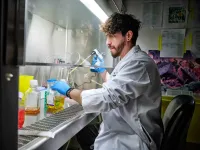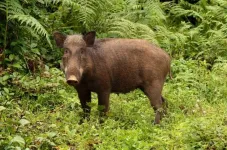Periodontitis: Researchers search for a new active substance
2021-03-03
(Press-News.org) Targeted, efficient and with few side effects: A new method for combating periodontitis could render the use of broad-spectrum antibiotics superfluous. It was developed and tested for the first time by a team from Martin Luther University Halle-Wittenberg (MLU), the Fraunhofer Institute for Cell Therapy and Immunology IZI and Periotrap Pharmaceuticals GmbH. The aim is to neutralise only bacteria that cause periodontitis while sparing harmless bacteria. The study appeared in the Journal of Biological Chemistry.
Periodontitis is a common bacterial inflammation of the gums. According to the World Health Organization WHO Oral Health Study, almost 10 percent of the global population are affected with a severe form of the disease, which can lead to tooth loss as well as increasing the risk of other diseases, such as Alzheimer's and cardiovascular disease. Until now, treatment has mainly involved the use of broad-spectrum antibiotics that attack all bacteria in the mouth. However, this has some disadvantages: "One side effect of the treatment is that it also destroys all the harmless or beneficial bacteria in the oral cavity. In addition, the bacteria can ultimately develop resistance to the antibiotics," explains Dr Mirko Buchholz from Periotrap Pharmaceuticals, who led the new study alongside Professor Milton T. Stubbs, a biotechnologist at MLU.
The researchers therefore looked for a way to eradicate only the harmful bacteria in the mouth. A team from Fraunhofer IZI's Department of Drug Design and Target Validation in Halle developed a test substance that attacks glutaminyl cyclase, a specific enzyme in the bacteria that plays a special role in metabolism. Inactivation of this enzyme harms the bacteria and, ideally, no periodontitis can develop. To test its effectiveness, the researchers joined forces with the Clinics for Dental Medicine at the University of Bern, Jagiellonian University in Krakow and the University of Louisville in Kentucky (USA). They found that the new substance successfully suppresses the growth of pathogenic bacteria.
The new test substance has a special feature: It only works on the harmful bacteria. "Our target, glutaminyl cyclase, comes in two different variants. Normally, plants and bacteria have one variant of the enzyme and mammals another. The two variants work in a similar fashion, but they differ significantly in their structure. It's a bit like flat-tip versus Phillips screwdrivers," explains Stubbs. Surprisingly, the bacteria that trigger periodontitis have the mammalian variant of the enzyme. "This is crucial for our approach because it gives us a possible target so we only kill the pathogenic bacteria and leave the harmless ones intact," says Mirko Buchholz. To minimise possible side effects in advance, the team compared the bacterial enzyme with the human variant. "There are small but significant differences between the enzymes," says Stubbs. These differences are probably sufficient for the new substance to not affect the human enzymes. Therefore, only minor side effects are to be expected.
The researchers' study provides initial evidence that the approach essentially works. It must now be fine-tuned in further studies and tested in subsequent clinical trials. It may therefore take some years before the research from Halle becomes a marketable drug.
INFORMATION:
Study: Taudte N. et al. Mammalian-like type II glutaminyl cyclases in Porphyromonas gingivalis and other oral pathogenic bacteria as targets for treatment of periodontitis. Journal of Biological Chemistry (2021). Doi: 10.1016/j.jbc.2021.100263
ELSE PRESS RELEASES FROM THIS DATE:
2021-03-03
Ask Eric Weaver about pandemics, and he's quick to remind you of a fact that illustrates the fleeting nature of human memory and the proximal nature of human attention: The first pandemic of the 21st century struck not in 2019, but 2009.
That's when the H1N1/09 swine flu emerged, eventually infecting upwards of 1.4 billion people -- nearly one of every five on the planet at the time. True to the name, swine flus jump to humans from pigs. It's a phenomenon that has been documented more than 400 times since the mid-2000s in the United States alone.
"They're considered the great mixing vessel," said Weaver, associate professor of biological sciences at the University of Nebraska-Lincoln. "They're susceptible to their own circulating ...
2021-03-03
Parents who reported more hassles using a child car seat or booster seat - such as the child is uncomfortable or having to make multiple trips in a day - were less likely to follow recommendations from the American Academy of Pediatrics (AAP) on child passenger safety, according to a study published in the journal Academic Pediatrics.
Researchers obtained information about transportation safety behaviors and 20 hassles when using child car seats among 238 socioeconomically and racially diverse parents of children 1 to 10 years of age. Eighty percent of parents reported at least a little bit of a problem with one ...
2021-03-03
Neurodegenerative disorders such as Parkinson's and Alzheimer's disease are in the firing line after researchers identified an attractive therapeutic drug target.
An international collaboration, co-led by University of Queensland researchers, has isolated and analysed the structure and function of a protein found in the brain's nerve fibres called SARM1.
Dr Jeff Nanson said the protein was activated when nerve fibres were damaged by injury, disease, or as a side effect of certain drugs.
"After a damaging incident occurs, this protein often induces ...
2021-03-03
Fireworks are used in celebrations around the world, including Independence Day in the U.S., the Lantern Festival in China and the Diwali Festival in India. However, the popular pyrotechnic displays emit large amounts of pollutants into the atmosphere, sometimes causing severe air pollution. Now, researchers reporting in ACS' Environmental Science & Technology have estimated that, although so-called environmentally friendly fireworks emit 15-65% less particulate matter than traditional fireworks, they still significantly deteriorate air quality.
Fireworks displays can cause health problems, such as respiratory ailments, because they ...
2021-03-03
Wine lovers recognize that a perfectly paired wine can make a delicious meal taste even better, but the reverse is also true: Certain foods can influence the flavors of wines. Now, researchers reporting in ACS' Journal of Agricultural and Food Chemistry have explored how lipids -- fatty molecules abundant in cheese, meats, vegetable oils and other foods -- interact with grape tannins, masking the undesirable flavors of the wine compounds.
Tannins are polyphenolic compounds responsible for the bitterness and astringency of red wines. Wine testers have noticed that certain foods reduce these sensations, improving the flavor of a wine, but scientists aren't sure why. Some studies have ...
2021-03-03
DALLAS, March 3, 2021 -- American Indian people with atrial fibrillation (AFib) had the highest risk of non-hemorrhagic stroke when compared with people in other racial and ethnic groups, and they also experienced the highest overall risk for stroke even without atrial fibrillation (AFib), according to new research published today in the Journal of the American Heart Association, an open access journal of the American Heart Association.
"In previous research, we have confirmed that American Indian individuals, when compared with those in other racial or ethnic groups, have the highest risk of atrial fibrillation, which is a quivering or irregular heartbeat that can substantially increase the risk of blood clots and stroke," said lead study ...
2021-03-03
DALLAS, March 3, 2021 -- The association between race and ethnicity and specific characteristics of some U.S. counties may have a significant impact on death rates related to cardiovascular disease, according to new research published today in the Journal of the American Heart Association, an open access journal of the American Heart Association.
Cardiovascular disease is the leading cause of death in the U.S. across all racial and ethnic groups, and disparities in cardiovascular outcomes for racial and ethnic minority groups have been documented extensively. This study presents a detailed analysis of county-level predictors of cardiovascular ...
2021-03-03
The first proof of the origin of malignant rhabdoid tumour (MRT), a rare childhood cancer, has been discovered by researchers at the Wellcome Sanger Institute, the Princess Máxima Center for Pediatric Oncology in the Netherlands, and their collaborators.
The study, published today (3 March 2021) in Nature Communications, found that MRT arises from developmental cells in the neural crest* whose maturation is blocked by a genetic defect. The team also identified two drugs that could be used to overcome this block and resume normal development, bringing hope of new treatments for the disease.
Malignant rhabdoid tumour (MRT) is a rare soft tissue cancer that predominantly affects infants. ...
2021-03-03
A robotics platform designed by Toronto researchers to screen thousands of COVID-19 samples at once has the potential to revolutionize how labs track the spread of viruses and other pathogens, according to new findings.
The END ...
2021-03-03
Wild pigs are often maligned as ecosystem destroyers, but a University of Queensland study has found they also cultivate biodiverse rainforests in their native habitats.
Dr Matthew Luskin has been researching the effect of native pigs in Malaysian rainforests and found their nests may be critical to maintaining diverse and balanced tree communities.
"We've shown that wild pigs can support higher diversity ecosystems and are not just nuisances and pests, thanks to a beneficial effect of their nesting practices," Dr Luskin said.
"Prior to giving birth, pigs build birthing nests made up of hundreds of tree seedlings, usually on flat, dry sites in the forest.
"As they build their nests, the pigs ...
LAST 30 PRESS RELEASES:
[Press-News.org] Periodontitis: Researchers search for a new active substance



